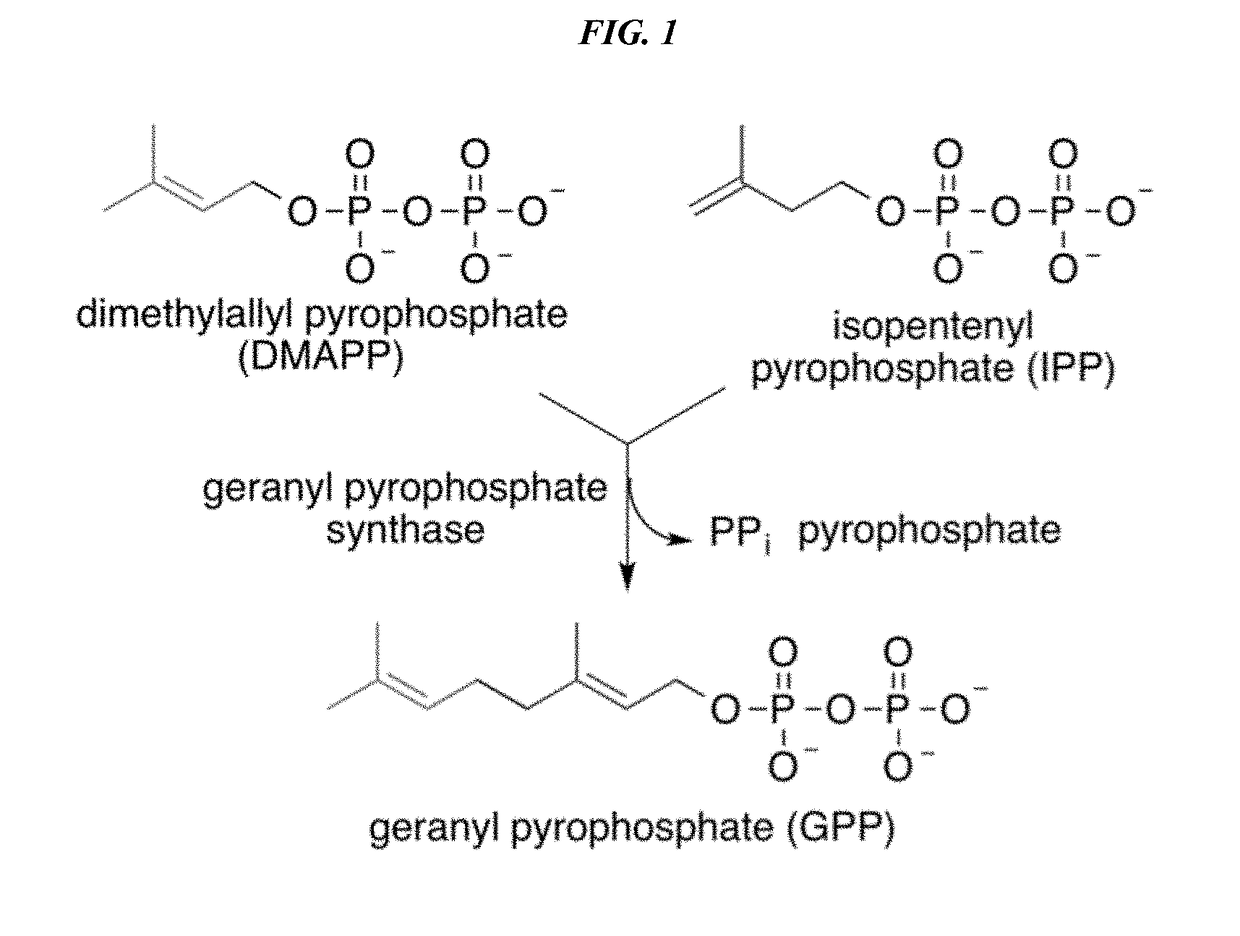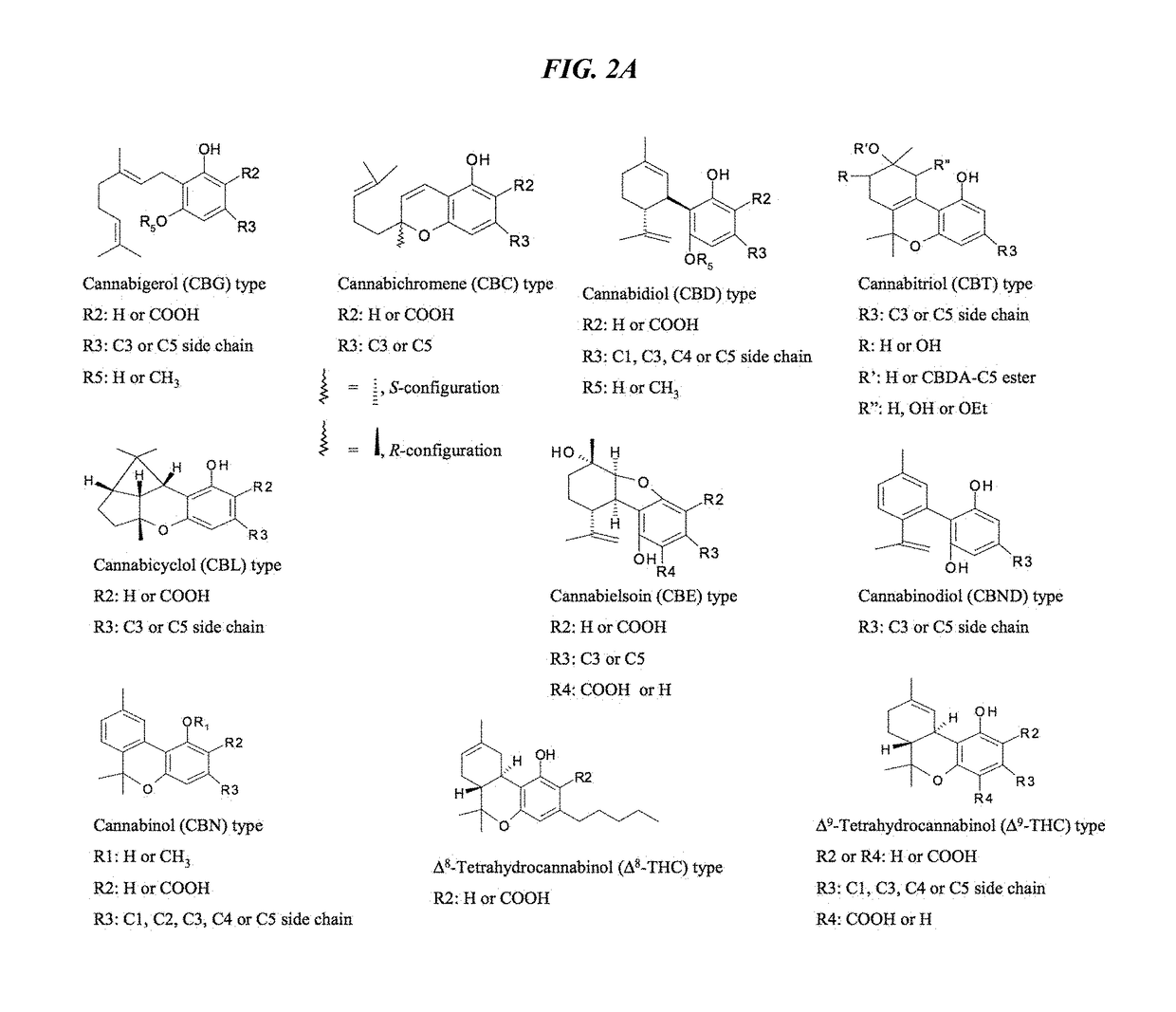Recombinant production systems for prenylated polyketides of the cannabinoid family
a technology of prenylated polyketides and recombinant production systems, which is applied in the direction of lyase, fermentation, biochemistry apparatus and processes, etc., can solve the problems of unfulfilled need for pharmaceutical grade cannabinoids using sustainable, modern biopharmaceutical preparation methods, and inconsistency in the activities of desired pure compounds,
- Summary
- Abstract
- Description
- Claims
- Application Information
AI Technical Summary
Benefits of technology
Problems solved by technology
Method used
Image
Examples
example 6
sis of Olivetolic Acid and its Analogs in Yeast
[0120]S. cerevisiae yeast strains containing one of the acyl-CoA synthetase genes CsAAE1, CsAAE3, or the middle chain fatty acyl-CoA ligase revS gene from Streptomyces sp. SN-593 were co-transformed into yeast using the Ura3 and Leu2 selectable markers on plasmids that contained the C. sativa olivetolic acid synthase and cyclase genes, driven by the ADH2 promoter and separated by the yeast p150 internal ribosome entry site (IRES) to generate a dicistronic mRNA, were grown in 25 ml shake-flask cultures in rich media with 2% glucose. After 30 hours, the yeast cultures were fed with various aliphatic carboxylic acids and the media was sampled at various time-points by reversed-phase HPLC. As shown in FIG. 5, all acids tested gave products in varying yields. The hexanoic acid feed gave high yields of olivetolic acid with a side-production of low levels of olivetol.
[0121]FIG. 5 depicts the production of polyketide cannabinoid precursors oliv...
example 7
iquitin Fusion Technology to Improve Cyclase Activities
[0122]The experiments of EXAMPLE 6 were repeated with a co-transformed plasmid that also encoded a human ubiquitin gene fused in-frame to the 5′-end of the cyclase gene, or a truncated cyclase gene. Upon hexanoic acid feeding and HPLC analysis of the media, high levels of olivetolic acid were observed.
example 8
ions with Varying Feed Protocols
[0123]Multiple 7.5 liter fermenters (Eppendorf) were run at an initial working volume of three liters, and with standard fed-batch glucose / media feed protocols in order to maximize production of olivetolic acid with simultaneous glucose and hexanoic acid feeding. The strains described in EXAMPLE 6 were grown to 350 mL overnight in defined uracil and leucine deficient media prior to inoculation into the fermenter, containing 2×YEP with 1.25% glucose. Agitation was set at 400-600 rpm, with aeration at a 1-2 vvm (liters of air / per liter of media / minute). Feeding with 2×YEP / 20% glucose was controlled such that the feed matched the yeast cell growth-rate with no build-up of glucose or ethanol. At 30 hours post-inoculation, 3 mL of hexanoic acid was added to the leftover feeding medium, providing a hexanoic acid feeding rate of about 48 uL / L / hr. The fermentations and feeding were continued to 54 hours post-inoculation at which point, a further 2.5 mL of hex...
PUM
| Property | Measurement | Unit |
|---|---|---|
| molar ratio | aaaaa | aaaaa |
| concentrations | aaaaa | aaaaa |
| concentrations | aaaaa | aaaaa |
Abstract
Description
Claims
Application Information
 Login to View More
Login to View More - R&D
- Intellectual Property
- Life Sciences
- Materials
- Tech Scout
- Unparalleled Data Quality
- Higher Quality Content
- 60% Fewer Hallucinations
Browse by: Latest US Patents, China's latest patents, Technical Efficacy Thesaurus, Application Domain, Technology Topic, Popular Technical Reports.
© 2025 PatSnap. All rights reserved.Legal|Privacy policy|Modern Slavery Act Transparency Statement|Sitemap|About US| Contact US: help@patsnap.com



